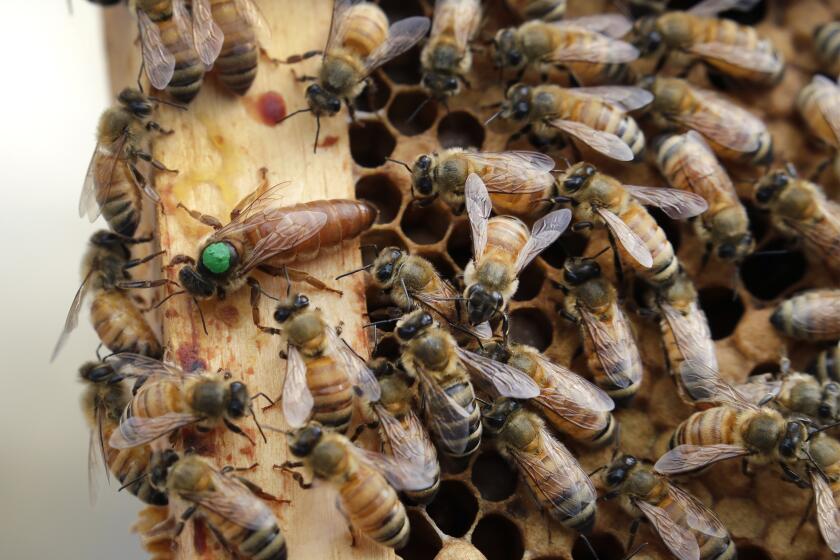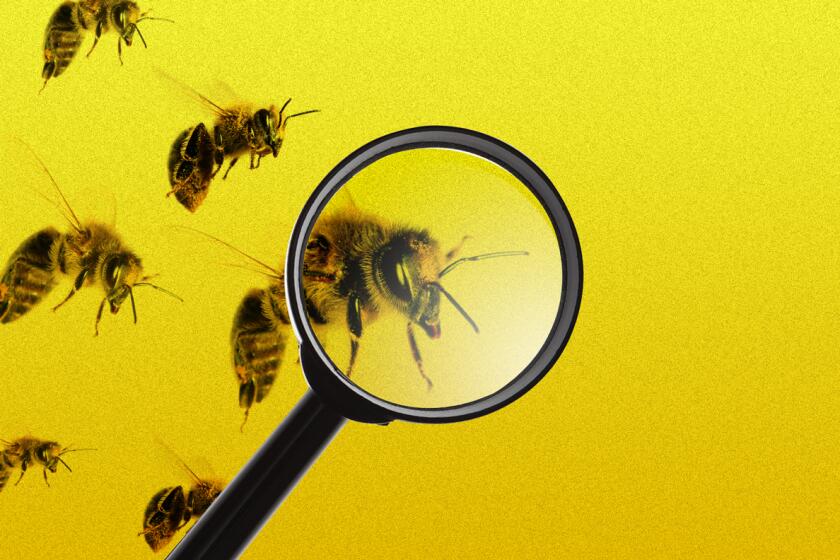- Share via
- Share via
Marvin Jordana laid a hand on the beehive in his Eagle Rock backyard and said a silent prayer.
After a few moments, he spoke: “I ask for their permission to enter the hive, because this is their body. With so much respect and humility, I ask them.”
Four people dressed in full bee suits, closed-toed shoes and thick rubber gloves looked on reverentially, ignoring the dozens of bees buzzing lazily around their heads.
Jordana wore just a veil over his head, leaving his arms and hands bare.
He pulled out a small metal tool that looked like a flat wrench and cracked open the top of the hive. The bees had glued it down from the underside with propolis — a sticky substance they create with tree resin.
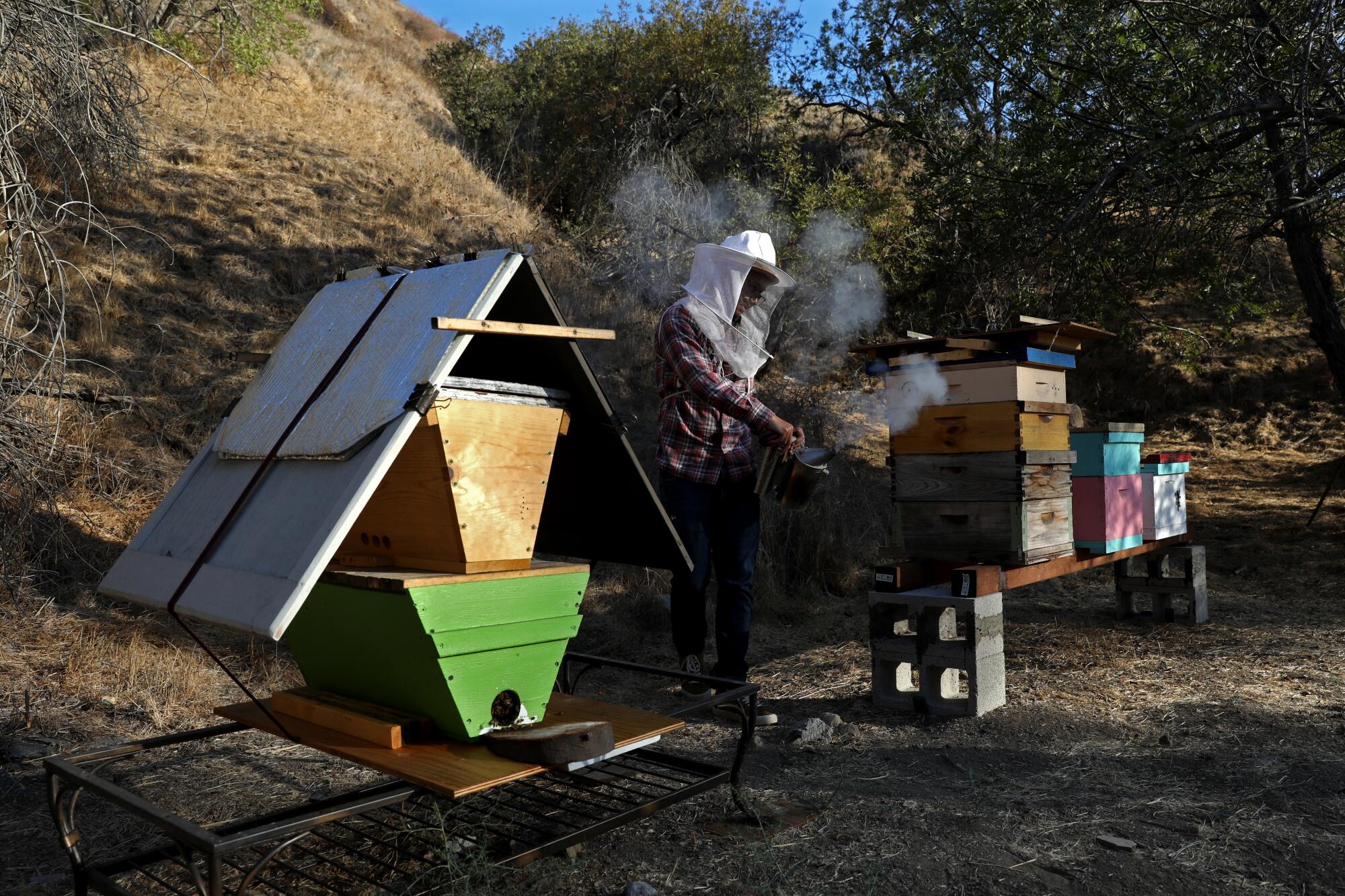
Jordana exudes calm, but now he slowed his movements even more.
Gently he lifted the lid.
And so began a journey into the sacred realm of the bees, a two-hour workshop led by Jordana, a 50-year-old beekeeper, deejay, yoga instructor and single father to his 21-year-old son.
He spends most of his days tending eight apiaries around Los Angeles, but he doesn’t sell honey. Instead, he supports his bee veneration by sharing his devotion in the $40 workshops. He calls the session “Honey Bee Therapy” because everyone enters a trance-like state, transfixed by the beauty of something they once feared.
As he removed the flat wooden top of the hive, the sound of buzzing got louder.
“Hi, ladies! Hi, ladies!” he called, opening the hive to the sun. “I know, the light, the light, the light.”
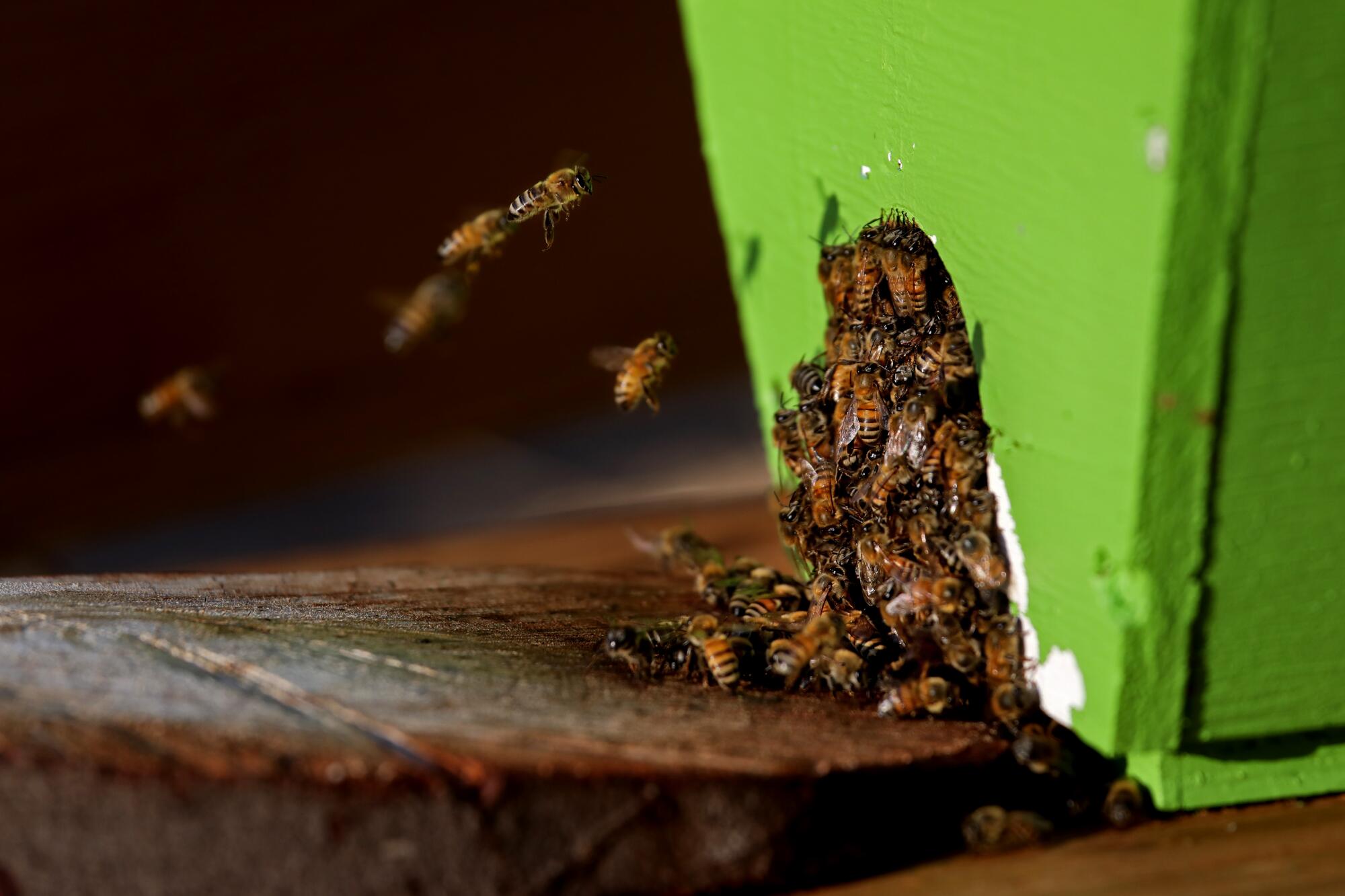
Cautiously, the visitors stepped forward to look at the busy, bustling world vibrating inside.
Lots of backyard beekeepers say their hobby is meditative. One must move thoughtfully and deliberately around a beehive — a kind of apian tai-chi. But for Jordana and the small but growing handful of beekeepers who see their work as a spiritual practice, communing with bees also provides an encounter with an ancient wisdom.
“I tell people, imagine a consciousness that has been around for almost 100 million years, and that has a symbiotic relationship with the planet,” Jordana said. “This is the consciousness of the bees.”
::
Jordana’s own initiation into the spiritual realm of beekeeping occurred 10 years ago on a rooftop in Silver Lake.
He was visiting a friend’s hive when a bee stung him on the temple. Moments later, another bee flew into his ear. It didn’t sting him but buzzed inside his head for two agonizing, eternal minutes before flying away.
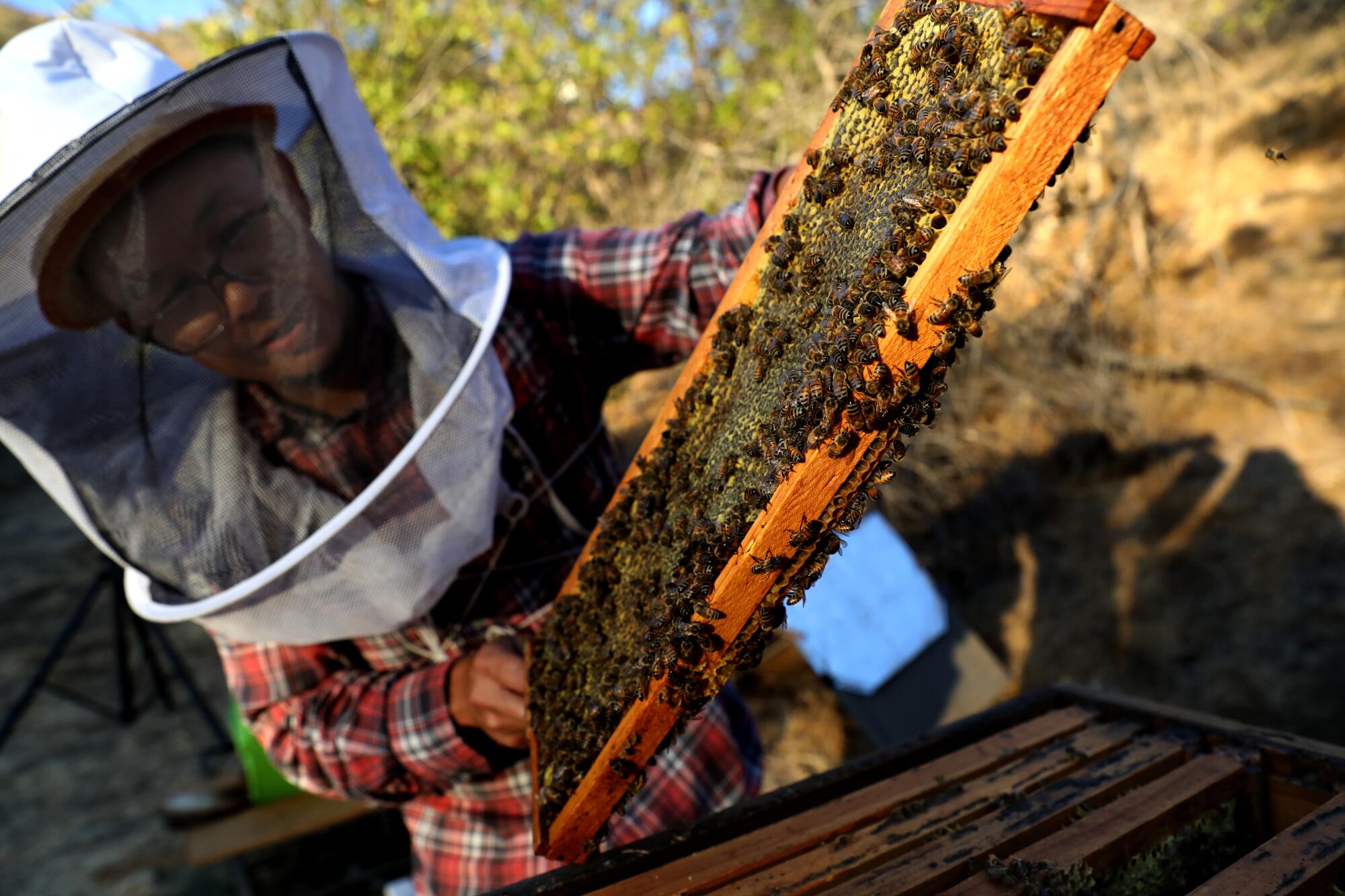
“All I could hear was BZZZZZZZ, BZZZZZZ, BZZZZZZZZZZZZZZ,” he said. “My heart was just pounding and pounding.”
It was a life-altering experience.
“The way I perceive it is the bees tapped me on the head, and then they went inside my ear to give me a message,” he said. “It’s like, ‘You work for us now.’”
Now he spends 20 hours a week at his day job providing fire protection services for commercial and residential buildings and most of the rest of his time engaged with bees: tending hives, rescuing colonies that would otherwise be exterminated, and running his workshops through Airbnb.
“I can’t imagine having this relationship and not sharing it with people,” he said.
Before bringing a group out to see his hives one recent day, Jordana asked them to introduce themselves.
Azize Ngo and Addi Ajmani had been apprenticing with a beekeeper in the Bay Area before they moved to Los Angeles a few months ago, looking to continue their education.
Amunet Hatsheput, whose pointed nails were painted in variations of yellow, black and gold to go with the bee theme, said she wanted to conquer her discomfort around the insects. She brought a tripod, an iPad and a digital camera to document the workshop for her new YouTube channel.

And Emma Freud, a British columnist, was hoping to learn how to tend to the beehives she has on her property in the English countryside.
“I don’t know how to look after them,” she said. “I pay a man to do it.”
Jordana welcomed them all with a smile.
“This gathering has been happening for thousands of years,” he said. “Today we are following in the tradition of humans that have dared to go and face this being.
“You may see thousands of bees, but it’s actually one being,” Jordana continued. “And we’ve been encountering this being since before we were even homo sapiens. Monkeys and chimps have been known to raid beehives.”
A prominent TikTok beekeeper has come under fire for a video of herself relocating a swarm of bees. “We know you’re faking,” says an L.A. beekeeper.
One of the oldest known images of a human taking honey from a hive is a 5,000-year-old painting discovered in a cave in Spain. It depicts a person with long hair dangling from a rope ladder and approaching a small depression in the rock while surrounded by bees.
The earliest record of large-scale beekeeping comes from Egyptian hieroglyphs dating back 4,500 years.
Bees were revered by the ancient Egyptians. They believed that the sun god Re wept and his tears became bees. Hieroglyphs from tombs dating back 2,600 years show a man kneeling in front of a row of hives with his hands outstretched in praise.
The Greeks considered the bee a divine animal that represented both the goddess Demeter and her daughter Persephone, Jordana said. The priestesses of rites known as the Eleusinian Mysteries were called Melissae, which means “bees” in Greek.
Later on, medieval manuscripts would depict the Roman Catholic Church as a hive with the priest as queen bee, cardinals as drones and lay people as worker bees. (No one knew the largest bee in the hive had ovaries yet.)
But over time, humans abandoned this ancient view of bees as sacred.
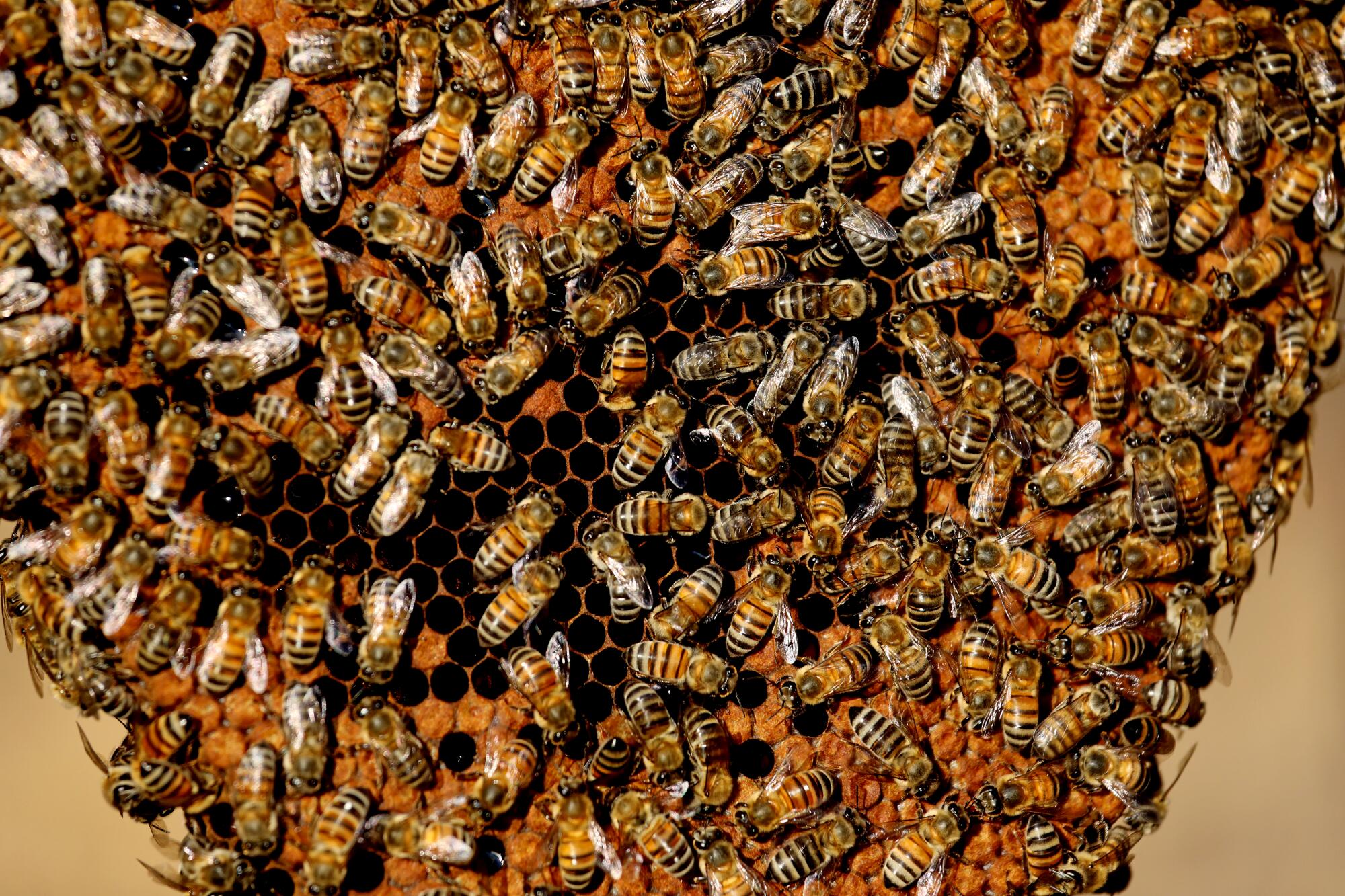
“Now beekeeping is a mechanistic, profit-driven, multibillion-dollar industry that uses this once divine insect to feed us humans,” Jordana told the group.
Each year millions of bees are carted from place to place, flying farmworkers tasked with pollinating fields of almonds, apples, blueberries and other crops before being loaded back onto semi-trucks and moving on to the next farm.
Commercial beekeepers feed their bees sugar syrup and give them manufactured pollen patties to feed their young, which Jordana says disrupts the natural processes of the hive.
Farmed bees are also exposed to large quantities of pesticides as they go about their work, which they bring back to the hive, Jordana said. And they are given antibiotics several times a year to protect them from bacterial infections.
If all this human interference is supposed to be helping the bees, it doesn’t seem to be working.
From April 2020 to April 2021, beekeepers across the United States reported the loss of 45% of the 2.71 million managed bee colonies, according to a survey by the nonprofit Bee Informed Partnership. That’s the second-highest loss rate since the survey started in 2006.
Bees are the most economically valuable pollinators of agricultural crops worldwide, responsible for the production of one-third of the food we eat — so there has been plenty of funding for research to explain their decline.

Scientists have concluded the cause is probably a confluence of factors, including pesticides, new parasites and other stresses that compromise the bees’ immune systems such as apiary overcrowding, contaminated water supplies and migratory stress.
“Just like how the people that collect our food are treated the worst and exposed to so many chemicals, that’s what we’re doing to the bees too,” Jordana said.
::
During his workshop, Jordana detailed the unique life cycle of bees and the inner workings of the hive.
The group was astounded to learn that a queen bee takes just a few “nuptial flights,” soaring high into the air to mate with up to 24 male bees on a single flight. Once her sperm sack is full, she will spend the rest of her life laying eggs, never needing to mate again.
Most of her children are female, and it is they who are charged with protecting the hive, cleaning it, foraging for nectar and taking care of the babies. The males, known as drones, don’t have jobs and have to beg their sisters for food. Their one purpose is to find another queen and mate with her. Afterward, most of them die.
Two new studies show ways L.A. gardeners can help bees by avoiding this too-common insecticide and planting what’s beneficial.
Jordana also talked about the alchemy that bees perform — they reduce the sugar content of nectar and turn it into honey in their honey stomachs. They also make a layered cake of honey, nectar and pollen—called “bee bread” — that they ferment to feed their young.
“Imagine a hexagon-shaped cupcake with layers of colors,” Jordana said. He marvels at the process: “It’s like, how do they know how to bake?”
Finally, Jordana asked the group to join him in a buzzing meditation. He had them cover their eyes with their hands and put their thumbs over their ears. On the out breath, they made the sound “hmmm” or “bzzzz.” (Try it!)
He picked a Tibetan singing bowl off the table and gently struck it.
“Take deep breaths like you are drinking the best glass of water, and feel the vibrations relaxing your face, relaxing your jaws,” he said.
The group inhaled.
He struck the bell again, and together they buzzed.
::
“There are so many institutional systems that are modeled after bees but I think we’re missing an important message from them — the symbiotic relationship.”
— Azize Ngo
Everyone took a selfie in their bee suit.
Jordana gave them drops of honey on Popsicle sticks to hold at the hive entrance — an offering to the bees. They looked at the insects through their magnifying glasses, admiring their furry coats and exclaiming over their strange thin brown tongues. Once the hive was open, they each took a turn holding a wooden frame and searched for the queen.
Jordana pointed out where the babies were being tended by nurse bees, and how the bees made a scaffolding out of their bodies at the bottom of the frame — their way of building new comb.
“It’s Cirque du Soleil,” Freud said.
When it was time to put the bees away, they watched in amazement as guide bees raised their little striped butts in the air, sending pheromones to their sisters that signaled it was time to head back inside. Jordana made sure every bee was carefully tucked away before closing the hive.
“I have to be so careful,” he said. “I don’t want to hurt a single bee’s leg.”
When it was all over, Jordana put out jars of honey and small tasting spoons and asked the group to share what they had learned.
Ajmani spoke about feeling a sense of rejuvenation. “I’m honored to be in their space and around them,” she said.
Ngo was flooded with humility and respect for a collaborative and resilient creature that has so much to teach humanity.

“There are so many institutional systems that are modeled after bees, but I think we’re missing an important message from them — the symbiotic relationship,” Ngo said.
Hatsheput said spending time with the bees was a lesson in loyalty because of the way they took care of the queen. She also found that she was able to release a lot of her anxiety around bees.
“No matter where I am in the world, I will keep this moment with me, locked up in a safe, in my heart,” she said.
And for Freud, looking at all those tiny insects made her feel tiny in the best way: “It’s that sense of perspective where you suddenly go — we are nothing, we know nothing, we understand nothing — and these are the guys who know.”
Jordana asked if the group wanted to do one last meditation together. The answer was a resounding yes.
This time he pulled out a wide flat drum and asked everyone to imagine they were part of a small community of hunter-gatherers in a time before language, and one of them had just found a beehive in the forest.
With their eyes closed, they pictured encountering the tree with honey dripping down its trunk (bumm), the quickening of their heartbeats as the buzzing of the bees grew louder (bumm bumm), the realization that even the bravest among them could not get to the hive without being stung (bumm bumm bumm) — and, finally, the decision to share what honey had fallen from the hive together, as a community.
“What was honey called even before it was called honey?” Jordana asked. “It must have been a sigh or a joyful (bumm) expression (bumm).”
Then the contemplative moment went a different direction.
“And imagine us just sharing this delicious (bumm) delicious (bumm) honey, which is literally (bumm) the sun having sex with the flowers (bumm bumm).”
The group opened their eyes and laughed.
More to Read
Sign up for Essential California
The most important California stories and recommendations in your inbox every morning.
You may occasionally receive promotional content from the Los Angeles Times.

